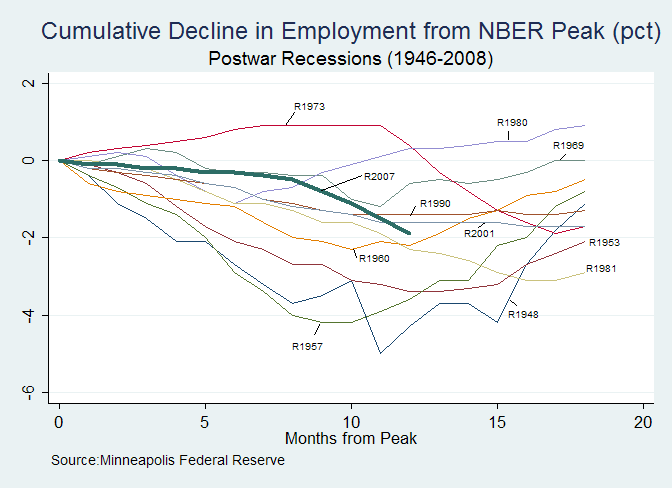Recessions Graph
In this post I linked to a graph that was designed to provide some context for the current recession in terms of past recessions. However, Alex Tabarrok has posted an update entry noting that the Minneapolis Fed’s graph for Mild, Median and Harsh recessions were actually “Frankenstein” graphs. As a result Alex has posted a graph of all recessions along with the current recession data so far. I thought I’d post the graph here as well since a number of commenters seemed interested in that post.
To see the image in a higher resolution, click on the image.
Based on this new information the current recession is looking similar, at least in terms of unemployment like 1981. The 1981 and the 1973 recessions are the longest post war each at 16 months.





Thanks, Steve. Very illuminating. Note that it highlights something I’d intended to point out in the comments to your last post comparing recessions: pointing out a current trend isn’t particularly meaningful when talking about the business cycle because it’s a cycle.
Steve –
Your detractors will cite the trend, implicitly assuming the trend takes us to Armageddon.
Your supporters (like me) will observe that the data available so far indicate a serious recession within the normal range of mild to bad, and that current doomsday rhetoric is not helpful in any way shape or form.
Perhaps I am too scarred. I came of (business) age in the 1981-1982 recession, as a participant in the steel industry. I understand current concerns. But I feel like some grizzled old vet telling the young’ns to chill. Hold yer sheet in peoples; this too, shall pass.
My inner cynic tells me this is all pretext to the rationale for govt action. As I posted recently, as we stand today, our unemployment rate stands at the rate prevailing about 20% of the time during the post war period, and for at least one year under every President except Johnson and Nixon.
Right now, I’m not seeing Armageddon……….unless, of course, the real story line is laying the propagandistic groundwork for King Obama, Lord of the Government Interventionists.
Fun facts to amaze your friends, ans what the gloom and doomers don’t want you to know:
(Courtesy Powerline)
The Center for Economic and Policy Research points out:
Over the eight years of the Bush administration, the average real hourly wage increased by 7.1 percent, almost the exact same as the 7.3 percent increase over the eight years of the Clinton administration.
I’m pretty sure that “real hourly wage” doesn’t include benefits, which account for an ever-growing share of employee compensation. If that assumption is correct, both of the above figures are way too low, and the figure for the Bush years is probably higher than that for the Clinton years.
And just when you were sure life as we know it had ended……….
Great graph, Steve, about what I thought was in store for the general public…
Mind you, I am not the general public. As a carpenter I expect a much harder time than in ’81 (because of the collapse of the housing bubble)
Soooooo… How do you see that particular aspect of the economy shaking out over the next few years, and how do you see it affecting the rest of the economy?
As Drew noted I will pipe in that in all but two of the other post war recessions the trend was back up by this point. How much longer we will trend down and where we will bottom out are still open questions.
That assumes of course the same standard over that entire period of time. That is a false assumption.
Another incorrect assumption. Real hourly wage includes your pay minus work associated expenses (gas, work clothes, etc) plus benefits (health insurance, life insurance, company car, etc).
If one limits oneself to wages the picture is quite different. I just took a quick look at the BLS website and found the data for employees on nonfarm payrolls. Average hourly wage in 1993 was $11.05 (14.93 2005$) compared to $14.02 (15.90 2005$) in 2000. Average hourly wage in 2001 was $14.54 (16.03 2005$) compared to a projected $18.05 (16.76 2005$) in 2008.
That’s a 6.5% increase during the Clinton years and a 4.6% increase during the Bush years. Calculate in the stagnant 34.3 hrs/wk during the Clinton years with the drop from 34.3 to 33.6 hrs/wk during Bush’s years and that’s a 6.5% increase during the Clinton years as opposed to a 3.4% increase during the Bush years for weekly wages. I am guessing that if we were to add farm payrolls the the picture would be more skewed.
It seems that the skyrocketing cost of health insurance accounts for the difference in the real hourly wages over the course of their respective tenures. Could it be that powerline would use an intentionally misleading stat?
Given that we are not getting appreciably more for that ever increasing health care cost workers saw a considerably greater increase in prosperity during the Clinton years than they did during the Bush years.
These numbers will be even more depressing once they have a serious impact on crime.
In the original chart the Minneapolis chart misdefined what they were showing.
Even after being informed that their description did not correctly identify what the chart was they still have not changed their incorrect comments.
I’d argue three: 1981, 1973 and 1953.
I’m unware of any changes in the measurement of unemployment that would make comparison’s across time problematic. If you have something post a link.
Hmmm, I’m not seeing this definition anywhere on the BLS website. I know many of the “real hourly wage calculators” out there on the web like to deduct things like lunch expenditures. However, this assumes that the person wouldn’t have eaten lunch if they weren’t working or that a sack lunch is free. Neither is the case so what one should really do is deduct the difference. If bringing a sack lunch has a cost of $2.75 and going to McDonalds costs $5 then the actual cost to the employee is $1.25.
I’m less thrilled with the deduction of day care expenses. After all one made a decision to have a child. Imputing that as something your employer should pay for strikes me as just silly.
The BLS hourly wage and salary data based on the CES does not include benefits, work related expenses, company car, etc. The series on employment costs from the National Compensation Survey does. However, they do not take into account things like clothing expenses. Again this is somewhat of an issue in that a job that requires say a suit does not limit the worker to wearing said suit in other non-work situations.
Spencer,
They have added additional information as to what they did. The idea of the charts is to create measures for the mildest, median and harshest recessions that are invariant over time so that as new data on the current recession becomes available they can update chart with only the line representing the current recession changing.
73 and 81 were the ones I originally referred to. It looks to me like 53 was trending slightly up by this point. It is pretty flat at this point and I guess it is arguable that it is sitting at the trough prior to increasing at this point. In any case it is no longer going down.
The main point stands though, that we simply do not know at this point but the trend is quite troubling.
I can’t find the link again to a change in the 80s. Perhaps I was misinformed elsewhere since it appears to have disappeared. The only difference I am finding now is the 1994 change in methodology from mail in survey to phone survey. That change may be problematic for comparisons though.
I couldn’t find it on the BLS website either. I don’t think they track it. I couldn’t easily find anyone who does. When I couldn’t find it there I just googled and compared a few definitions. Given the actual wage data over the period of time in question I am confidant the the CEPR calculations include benefits. I am also confident that powerline pulled that line out of the article to deliberately give a misleading impression about relative worker prosperity over those two periods.
I agree with the rest of what you wrote there other than on child care expenses, but that is not relevant to the point I was making with Drew. That point being that benefits are included in real hourly wage and that being the reason for the seeming parity in compensation between the Clinton and Bush years. That has nothing to do with your original post but I could not let it stand.
Grewgills –
“That assumes of course the same standard over that entire period of time. That is a false assumption.”
I am well aware of attempts to skewer the measurement technique over issues like “discouraged workers.” (Although I can flat damned guarantee you that argument will be deep sixed now that we have a Democrat administration.) Those types however also conveniently forget to consider the tremendous rise in the self employed, also not counted. As I have pointed aout a number of times. Yours truly is counted as unemployed. But, alas, it ain’t so.
I know of no study or person who does not have a political agenda who believes the accuracy of the measurement to have changed materially.
From the BLS website,
From the same page,
Given the above, how is it you feel you are counted as unemployed when you are not?
We’ll see. Somehow I doubt it though.
BTW care to change your tune re: wages during Clinton and Bush’s terms?